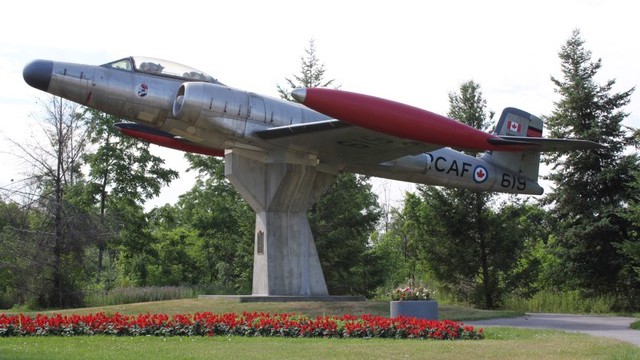Mississauga Considering Giving Iconic Malton Airplane to Museum
Published March 14, 2017 at 1:47 am

Last week, found out that Malton could lose its long-standing and iconic airplane monument–one that’s of significant importance to the community.
Although most people associate Mississauga’s Malton neighbourhood with Pearson Airport, it’s also closely associated with the the CF 100 aircraft monument that’s been an important part of the community for decades.
Last week, a well-placed source reached out insauga.com to say that recent discussions with leaders and members of the community have revealed that the iconic structure might be removed in the near future.
According to the source, there are concerns about the structural integrity of the monument and the natural deterioration that’s occurred over time.
Recently, Mississauga City Councillor Carolyn Parrish reached out to insauga.com to shed more light on the structural challenges and talk a little about what the city might do not only with the beloved monument, but also with the important Malton Cenotaph.
“The historic CF100 Canuck has been displayed on a concrete pedestal in the Legion Memorial Garden visible from Derry Road, close to Paul Coffey Arena, for more than 50 years. It is located as part of the Malton Cenotaph, honoring those who died in World War Two. The site is no longer easily accessible, in a location with increasingly heavy truck traffic and no sidewalk,” Parrish explained in an email, before outlining other changes the arena site has undergone in recent years.
“Huge improvements have recently been made at the arena site. A landscaped seating area on the Goreway/Derry corner contains heritage limestone preserved from the Boeing Plant originally built for the construction of the Avro Arrow supersonic jet interceptor. That building was demolished in 2005. The stone was donated to the city by the GTAA and has been incorporated in the seating area and pathways at the arena – a space easily accessed by foot with ample parking for cars in the arena parking lot.”
As far as the cenotaph goes, the city is considering moving the marker. Parrish said that if the plaque is removed, it will be refurbished on a tall base with the names of the Malton residents who served and died in the war, along with a description of the limestone’s history.
Parrish also mentioned the arena’s new mural.
“It’s also important to note that during the renovation of the Arena last year, Malton’s aviation history was beautifully preserved on a unique mural painted on the entrance wall. It is easily viewed from a seating area in the new Castles Playground being built this summer.”
As for the plane itself, Parrish said that planes are simply not designed to sit on concrete pedestals.
“No airplane was designed to be perched indefinitely on a concrete pedestal, concentrating all its weight onto one small contact point. Ours is one of a shrinking number still displayed this way, of the more than 27 remaining all over Canada. The vast majority are in airplane museums, sitting on their landing gear on level ground.”
According to Parrish, the plane has been reinforced and repaired over the years, but can no longer withstand further interference.
While it is important for officials to monitor any structural issues and act on safety concerns, it’s also easy to understand why removing the aircraft entirely will upset–perhaps deeply–members of the community who have grown attached to the structure.
Not only is the monument visually appealing, it pays tribute to Malton’s aviation heritage.
According to Heritage Mississauga, The A.V. Roe plant in Malton produced the Jetliner–North America’s first jet passenger plane–in 1949. By 1953, workers at the aircraft and engine plants were producing the CF100 all-weather jet interceptor for the Royal Canadian Air Force. Heritage Mississauga also notes that the plant designed and built the CF-100 (also known as the Canuck). That prototype flew for the first time in 1950 and in order to honour the community’s contribution to the industry, the Malton Legion raised one of the few remaining CF-100s in 1972.
But if the structure truly cannot be repaired or maintained as it is, what can be done?
“The question now is, do we stubbornly hang on to our Canuck despite its imminent, irreparable damage, or do we donate it to a museum to properly display for many years to come? As a member of the City’s Heritage Committee, I believe the CF100 should be preserved,” wrote Parrish. “I also believe those who served and died in the war need to be permanently recognized on a Cenotaph. I’m hoping both can be done in the near future after consulting with the Streetsville Legion, with which the Malton Legion has amalgamated, and local residents.”
So while residents are deeply upset about the potential loss of the monument (and understandably so), some may be encouraged to hear that the city is optimistic that it can be preserved–just not in that spot.
We will keep you posted on details as the story develops.
insauga's Editorial Standards and Policies advertising





